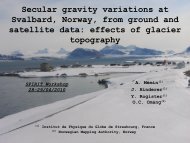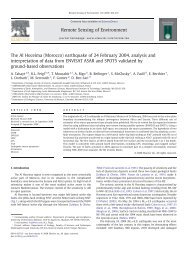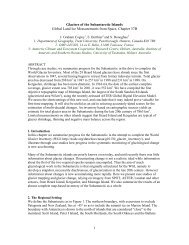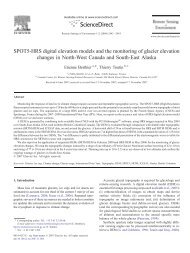Surface motion of mountain glaciers derived from satellite optical ...
Surface motion of mountain glaciers derived from satellite optical ...
Surface motion of mountain glaciers derived from satellite optical ...
Create successful ePaper yourself
Turn your PDF publications into a flip-book with our unique Google optimized e-Paper software.
E. Berthier et al. / Remote Sensing <strong>of</strong> Environment 95 (2005) 14–28 25Fig. 8. Displacements along a longitudinal pr<strong>of</strong>ile <strong>of</strong> the Mer de Glace glacier in the column image direction deduced <strong>from</strong> the 19 July and 19 August 2003image pair. All displacements were rescaled to 26 days. The small light grey squares are the displacements <strong>from</strong> SPOT images along a single pr<strong>of</strong>ile, whereasthe black triangles represent the mean <strong>of</strong> 5 parallel pr<strong>of</strong>iles separated by 25 m. The white diamonds are the DGPS displacements. The black circles (filled inwhite) represent the correlation coefficient <strong>of</strong> the <strong>satellite</strong> measurement (right axis). The grey triangles represent the <strong>satellite</strong> displacements after correction forablation.Fig. 9. Difference between the real and measured displacements caused bylowering <strong>of</strong> the glacier surface. This systematic error only affectsmeasurements in the column direction.absolute orientation. Consequently, we obtain two wellcoregistered images but with a shift relative to the DEM.The stereoscopic effect is less well modelled so thatsome distortions remain between the two images. Wechoose image pair #2 to test the accuracy obtainedwithout GCPs because this pair presents a weak stereoscopiceffect. The relative orientation <strong>of</strong> the two imagesis not significantly better with GCPs as shown in Table2. The comparison with the DGPS survey (Table 4)confirms that accurate displacements can be obtainedwithout GCPs. It is interesting to note that the differenceis even smaller in some locations. We obtain a similaraccuracy when using the GTOPO30 DEM (also withoutGCPs) instead <strong>of</strong> the high resolution DEM. It indicatesthat, with a good image pair, our methodology can beapplied to remote areas where no high resolution DEMis available. The main limitation in using a coarse DEMis that elevation errors in the DEM, combined with non-







